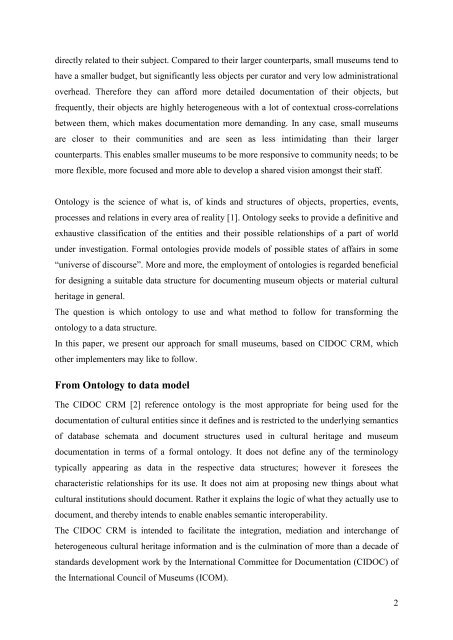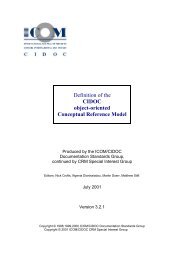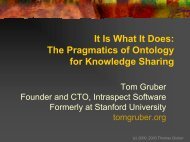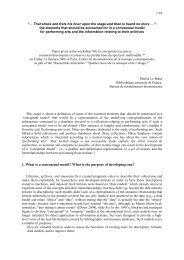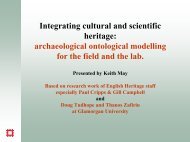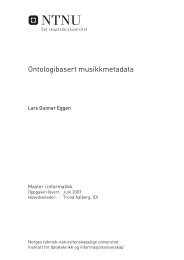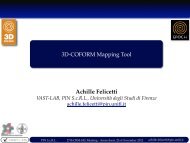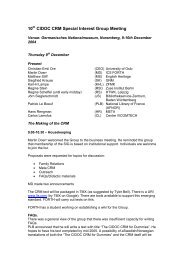documenting cultural heritage in small museums - The CIDOC CRM
documenting cultural heritage in small museums - The CIDOC CRM
documenting cultural heritage in small museums - The CIDOC CRM
Create successful ePaper yourself
Turn your PDF publications into a flip-book with our unique Google optimized e-Paper software.
directly related to their subject. Compared to their larger counterparts, <strong>small</strong> <strong>museums</strong> tend tohave a <strong>small</strong>er budget, but significantly less objects per curator and very low adm<strong>in</strong>istrationaloverhead. <strong>The</strong>refore they can afford more detailed documentation of their objects, butfrequently, their objects are highly heterogeneous with a lot of contextual cross-correlationsbetween them, which makes documentation more demand<strong>in</strong>g. In any case, <strong>small</strong> <strong>museums</strong>are closer to their communities and are seen as less <strong>in</strong>timidat<strong>in</strong>g than their largercounterparts. This enables <strong>small</strong>er <strong>museums</strong> to be more responsive to community needs; to bemore flexible, more focused and more able to develop a shared vision amongst their staff.Ontology is the science of what is, of k<strong>in</strong>ds and structures of objects, properties, events,processes and relations <strong>in</strong> every area of reality [1]. Ontology seeks to provide a def<strong>in</strong>itive andexhaustive classification of the entities and their possible relationships of a part of worldunder <strong>in</strong>vestigation. Formal ontologies provide models of possible states of affairs <strong>in</strong> some“universe of discourse”. More and more, the employment of ontologies is regarded beneficialfor design<strong>in</strong>g a suitable data structure for <strong>document<strong>in</strong>g</strong> museum objects or material <strong>cultural</strong><strong>heritage</strong> <strong>in</strong> general.<strong>The</strong> question is which ontology to use and what method to follow for transform<strong>in</strong>g theontology to a data structure.In this paper, we present our approach for <strong>small</strong> <strong>museums</strong>, based on <strong>CIDOC</strong> <strong>CRM</strong>, whichother implementers may like to follow.From Ontology to data model<strong>The</strong> <strong>CIDOC</strong> <strong>CRM</strong> [2] reference ontology is the most appropriate for be<strong>in</strong>g used for thedocumentation of <strong>cultural</strong> entities s<strong>in</strong>ce it def<strong>in</strong>es and is restricted to the underly<strong>in</strong>g semanticsof database schemata and document structures used <strong>in</strong> <strong>cultural</strong> <strong>heritage</strong> and museumdocumentation <strong>in</strong> terms of a formal ontology. It does not def<strong>in</strong>e any of the term<strong>in</strong>ologytypically appear<strong>in</strong>g as data <strong>in</strong> the respective data structures; however it foresees thecharacteristic relationships for its use. It does not aim at propos<strong>in</strong>g new th<strong>in</strong>gs about what<strong>cultural</strong> <strong>in</strong>stitutions should document. Rather it expla<strong>in</strong>s the logic of what they actually use todocument, and thereby <strong>in</strong>tends to enable enables semantic <strong>in</strong>teroperability.<strong>The</strong> <strong>CIDOC</strong> <strong>CRM</strong> is <strong>in</strong>tended to facilitate the <strong>in</strong>tegration, mediation and <strong>in</strong>terchange ofheterogeneous <strong>cultural</strong> <strong>heritage</strong> <strong>in</strong>formation and is the culm<strong>in</strong>ation of more than a decade ofstandards development work by the International Committee for Documentation (<strong>CIDOC</strong>) ofthe International Council of Museums (ICOM).2


